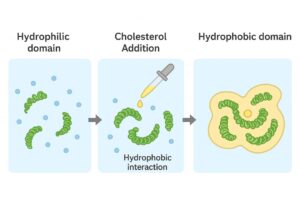2025 vol 4 issue 3
Full paper
Fateh Eltaboni 1 *, Mofida Makhloof 1, Hiba Bayou 1, Fatima Alhase 1
1 Chemistry Department, Faculty of Science, University of Benghazi, Qar Yunis, Benghazi, Libya, P.O. Box 9480
* Correspondence to :elfateh.belkasem@uob.edu.ly
pp. 209-222
DOI: 10.58332/scirad2025v4i3a3
PDF
Abstract
 The molecular interaction between fluorescein-labeled starch and cholesterol was investigated using a colorimetric approach by monitoring absorbance at 490 nm. Kinetic profiles were recorded for starch–cholesterol blends containing varying cholesterol concentrations, and experimental data were fitted to exponential decay models using GraphPad Prism software. According to the analysis, the interaction kinetics are adequately described by both one-phase decay and plateau followed by one-phase decay models, with higher cholesterol content resulting in longer interaction lifetimes and more robust hydrophobic associations within the starch matrix. At larger concentrations, viscosity and steric hindrance probably play a part, but other elements like probe aggregation or local microviscosity changes might also be involved. These results highlight the usefulness of colorimetric kinetics as a quantitative method for examining interactions between cholesterol and biopolymers that are pertinent to food, medicinal, and nutraceutical applications.
The molecular interaction between fluorescein-labeled starch and cholesterol was investigated using a colorimetric approach by monitoring absorbance at 490 nm. Kinetic profiles were recorded for starch–cholesterol blends containing varying cholesterol concentrations, and experimental data were fitted to exponential decay models using GraphPad Prism software. According to the analysis, the interaction kinetics are adequately described by both one-phase decay and plateau followed by one-phase decay models, with higher cholesterol content resulting in longer interaction lifetimes and more robust hydrophobic associations within the starch matrix. At larger concentrations, viscosity and steric hindrance probably play a part, but other elements like probe aggregation or local microviscosity changes might also be involved. These results highlight the usefulness of colorimetric kinetics as a quantitative method for examining interactions between cholesterol and biopolymers that are pertinent to food, medicinal, and nutraceutical applications.
Keywords
Molecular interaction, Fluorescein-starch, Cholesterol, Kinetics, Colorimetry
First published: 11.09.2025
